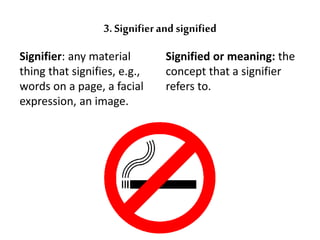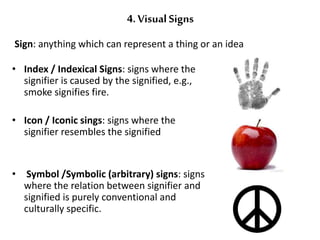Visual language
- 2. 1. COMMUNICATION PROCESS The channel or medium - It is the vehicle or means used to transmit the information Context Place and time Sender It is the person who creates an image in order to communicate Message It is the content of the image- its information The receptor It is the person who decodes the message to understand it The code They are the rules and norms that make the message understandable
- 4. The Function of the images Informative- Content is transmitted in an objective way
- 5. The Function of the images Aesthetic Images that communicate mainly beauty and harmony
- 6. The Function of the images Expressive Images stimulate the receiverâs feelings. The point is not what we see in the image, but the emotions we feel when we look at it
- 7. The Function of the images Exhortative They try to persuade the receiver to do something, to buy a product, to believe an idea or to do a task.
- 8. The Function of the images Narrative The image tells a story
- 9. The Function of the images Social
- 12. 2. Basic elements in visual language Dot Line Plane Colour Texture Volume
- 13. 3. Signifier and signified Signifier: any material thing that signifies, e.g., words on a page, a facial expression, an image. Signified or meaning: the concept that a signifier refers to.
- 15. 4. Visual Signs Sign: anything which can represent a thing or an idea âĒ Index / Indexical Signs: signs where the signifier is caused by the signified, e.g., smoke signifies fire. âĒ Icon / Iconic sings: signs where the signifier resembles the signified âĒ Symbol /Symbolic (arbitrary) signs: signs where the relation between signifier and signified is purely conventional and culturally specific.
- 16. SYmbols
- 17. 5. Iconicity of an image
- 18. 6. Types of images:: analytic image
- 19. Realistic images Antonio LÃģpez. Gran vÃa
- 20. Figurative images Paul CÃĐzanne Los jugadores de cartas. 1896
- 21. Abstract images Chema Madoz.




















